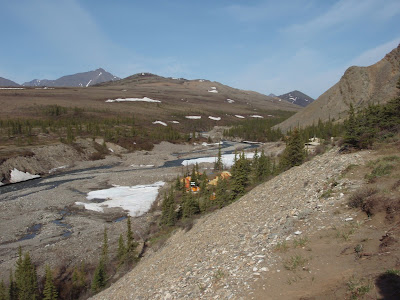June 18 Trip to Ivaavik with Parks Canada
Flying over the northern coastline gives you an entirely
unexpected perspective on Canada’s vast maritime border. The Beaufort Sea stretches across the western
arctic, longer than our two other coasts, and infinitely wilder and more
isolated. The vast Mackenzie delta
reaches out to the icy sea, spreading west from Inuvik for 60 km. From the air, it’s a maze of watery reaches
separated by the occasional band of tiny spruce trees or marshy tundra,
impossibly contorted and confusing. But
here and there are open boats shooting along towards fishing camps on isolated
hummocks, pairs of tundra swans camped in private lagoons, and bald eagles
scouting char and ducks. Towards the
west as the tundra rises into the most northerly reach of the Rocky Mountains,
clusters of migrating caribou range across the rolling dry hills, heading west
and north towards the arctic coast where summer grazing is rich and wind will
disperse the ubiquitous bugs. Then the
rocky peaks take over, sharply V-shaped valleys lined with rubble strewn
rapids. No glaciers ever smoothed these
rocks, so fragile shale crumbles down the slopes, eroding around the towering
volcanic rocks that remain standing on the mountain tops. These tors protrude like ugly teeth in long
ridges down the spines of the gravelly slopes.
Our plane followed a tumbling river to a wide flat valley in the
mountains, and there we landed at our camp in Ivaavik National Park, just below
the northern coast, in the north west corner of Canada.
Our camp was far more civilized than I had
anticipated. Parks Canada maintains a
summer facility for research and teaching here, so there is a permanent cook
shack, outhouse, workshop and tent encampment set up. Equipped for 30, we were lucky to have only
our group of 12 at the site, so we had the run of the posh equipment – spotting
scope, Coleman stoves, screen tents, and picnic tables! We were lucky to have some family members of
our 2 parks guides along too, all of whom gave us a fantastic view of life in
the north. The whole paradigm of hunting
caribou, Beluga whales, snow geese, and grizzly bears is pretty different from
my life in Kitsilano! It’s hard to
conceive of roast swan for Christmas dinner!
We spent 4 days at Sheep Creek Camp, fishing
(unsuccessfully – the rivers were very high), hiking, singing, socializing and
wildlife viewing. The weather was less than fabulous, in fact downright
hostile at times, so the photography is quite disappointing, but otherwise the
trip was fabulous. We hiked high into
the rugged mountains, following ridges past the massive tors, and up steep
scrambling pitches. The camp sits high
in the scrubby taiga forest, so most of our hiking was above the tree
line. It made spotting the wildlife
easier, and meant approaching grizzly bears couldn’t surprise us. In fact we only spotted one bear, across the
river, but he was big and scary enough for me!
We did see plenty of caribou – the males are following the earlier
migration of the females with calves, so they are lollygagging through the
mountains towards the coast. Sheep are
plentiful – an all white version of our Rocky Mountain bighorn sheep, and moose
left plenty of sign, but no visible appearances. Our camp was occupied by arctic ground
squirrels, or sik-sik, as they are known locally for their chirpy calls. Curious and friendly, they were everywhere,
including one little guy we dubbed Mr. Shitty Pants after he fell into the
outhouse and had to be rescued! Golden
eagles, terns, ptarmigan, swallows, and ravens entertained us daily.
The endless daylight was even more noticeable living in a
tent. Even with an eyeshade I would wake
to sunlight piercing our window at 3am.
Some of our group, not yet exhausted by 12 km day hikes, set off at 10pm
to bag yet another peak. Their photos of
midnight mountaintop panoramas were stunning.
I wished I had the stamina to join them but 3 days of challenging hill
climbing was enough for me. I could
happily have stayed on, especially as the sun came out as our plane arrived to
take us home, and 4 days seemed all too short to see enough of the animals and
geology in the park. If the opportunity
to return occurs, camping or river rafting on the Firth, I’ll be back. It’s a magnificent landscape and an
altogether stunning holiday.
Today we’re back in the camper in Inuvik for a few
days. There’s unpacking and laundry to
do before we reprovision and head back down south. For now though, the sun is out, the sky is
blue, and we’re enjoying life. Hope you
are too!
Posted at Inuvik Public Library.
 |
| THis is Sheep Creek, with our little camp on the plain below us. Yes, still ice! |
 |
| At the top! Rugged ground and somewhat challenging hiking, but we had fun. |
 |
| The wildflowers were beautiful. Up here their colours are very intense, supposedly to attract bees and butterflies. |
 |
| Sheep Creek and our tent site from the cook shack deck. |
 |
| Norbert is pointing to the peak he just climbed! No kidding! |
 |
| Our plane arriving on day 4, sunny at last. It's a twin otter, with huge tundra tires. And you should see the runway! |
 |
| Mackenzie delta from the plane. The ice is still around, and the water is really high and muddy. |
Another instalment of northern bliss. Such a pleasure to read, to be a voyeur, to accompany you in my mind for those brief but fulfilling moments.
ReplyDeleteHow can it be that such a corner of Canada can be so empty of humanity yet obviously so accessible to those who are motivated? I'm so glad you're doing this trip--for all of us.